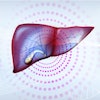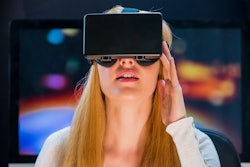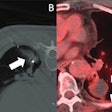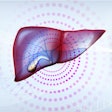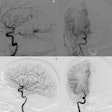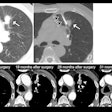A head-mounted augmented reality (AR) display can significantly improve ergonomics for interventional radiologists, researchers have reported.
The finding is based on survey results and an analysis of kinematic data that found the AR display reduced neck turns during musculoskeletal image-guided procedures by 47.6%, noted lead author Afareen Jaleel, MD, of Memorial Sloan Kettering Cancer Center in New York City, and colleagues.
“AR headsets demonstrated tangible ergonomic benefits in musculoskeletal [interventional radiology] procedures, reducing physical strain while providing user satisfaction,” the group wrote. The study was published November 4 in the Journal of Vascular and Interventional Radiology.
Interventional radiology procedures are primarily image-guided, and operators frequently turn their heads, necks, and torsos between the operating field and imaging display, resulting in repetitive strain. In a recent survey of 308 interventional radiologists, over 60% reported general musculoskeletal pain, with approximately 20% experiencing lumbar or thoracic discomfort and 24% reporting neck pain, the researchers noted.
In previous studies, AR technology has shown potential in the field by reducing procedure times, minimizing the number of acquired images, and decreasing radiation exposure during bone procedures. In this study, the researchers explored its ergonomic impact.
Nine interventional radiologists used the headset (Omnify XR, GE HealthCare and MediView) over a 15-day period in June 2024. Data were collected through an electronic survey with a 5-point Likert scale. The clinicians rated their experience in procedures including drainage, biopsy, endovascular, ablation, and cement augmentation.
The researchers also collected kinematic data from single-user motion analysis during 14 needle placement procedures (10 kyphoplasties, four spinal biopsies) and compared sessions enabled with AR (n = 7) versus sessions without AR (n = 7).
According to the results, user feedback indicated high median scores for comfort (5), ease of use (4), and positive ergonomic impact (5), with 66% reporting improved ergonomics. Limitations included moderate image quality (median score, 3) and occasional connectivity issues, although operators reported image quality was sufficient for safe procedure completion, the researchers reported.
The ergonomics kinematic analysis revealed that the median number of turns in the AR group was 21 compared with 31 turns in the control group, indicating a 47.6% reduction in turns (p = 0.003). There was also a statistically significant difference in turn magnitude, with median turn magnitude lower for the AR group (59.6°) compared with the control group (78.4°, p = 0.0002).
As this was a pilot study at a single center, the study’s generalizability is limited, the researchers noted. Future research should include multiple operators with varying AR experience across diverse procedural types, they wrote.
“AR headsets demonstrated tangible ergonomic benefits in musculoskeletal IR procedures, reducing physical strain while providing user satisfaction. Despite needed technical improvements, AR represents a promising solution to enhance procedural ergonomics and efficiency,” the group concluded.
The full study is available here.




